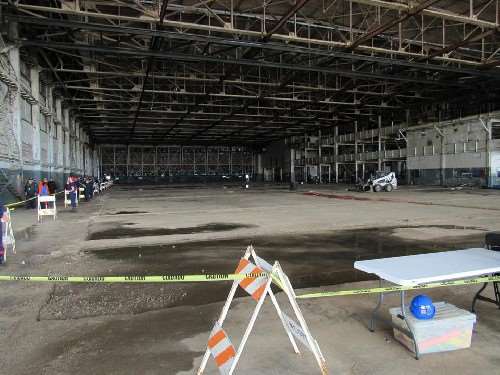Re: Romney's selective memory
Posted by Steve203 On 2015/8/24 13:28:56
When they were still assembling their own bodies prior to the '41 Clipper, who were they sourcing their stamping from? One assumes some were done in-house but larger components that required higher capacity press to create were likely out-sourced.
I think it is the 1944 annual report that shows the diagrams of the E Grand complex in it's prewar and wartime configurations. In the prewar configuration, the sheds along the railroad tracks south of Palmer are marked "stamping division", while the multi-story buildings along Concord south of E Grand are marked "body plant". They could have outsourced some stampings at the time. That would be easy to do with Briggs, Murray and Budd all running stamping plants and competing for business. By the 50s, Studebaker had Budd making the vast majority of it's stampings, shipping them nested to South Bend by rail.
<i>Briggs may have also pushed Packard for more business as I recall reading that they lost much of their Ford business as that company brought more bodymaking in-house by 1940.</i>
The body specialists had been losing business through the 30s as automakers brought bodybuilding in house.
The way that Packard transferred it's bodybuilding equipment to Briggs with apparently no documentation, and some accounts I have read saying Packard received a very attractive price from Briggs, for a couple years, then the prices soared, makes me think Gilman bartered the equipment for a discount. Avoiding a big CapEx program, and getting a discount on bodybuilding, will look good in the annual report, and make the stockholders happy, for a couple years. By the time that idea blew up on the company, Max was long gone.
Reading the Wiki entry on the 41 Clipper: the widest car in the industry, the largest stampings in the industry, I can imagine that it not only required new presses but new paint booths and ovens, and the columns in the multistory plant probably had a way of getting in the way.
<i>Of course, poor product planning and execution could still undo the good affect of even the best infrastructure.</i>
Evidence Kaiser at Willow Run, an operation that was initiated and maintained by a string of RFC loans. Tons of unobstructed space to run assembly lines. Bought for about a quarter of what it cost to build. Would have been a great move, if Kaiser knew how to build cars efficiently, and could have sold about 300,000/yr.
Speaking of Willow Run, a local aircraft museum bought the dual bay hanger at the east end of the plant for a new museum building. This is a pic I took during their open house in June, showing one of the two hanger bays. While Willow Run only made B-24s, it was designed to be large enough to accommodate B-29s, which were under development when Willow Run was built. Compare this to what Packard had to deal with: low ceilings and concrete columns everywhere.
Attach file:
 (108.63 KB)
(108.63 KB)

I think it is the 1944 annual report that shows the diagrams of the E Grand complex in it's prewar and wartime configurations. In the prewar configuration, the sheds along the railroad tracks south of Palmer are marked "stamping division", while the multi-story buildings along Concord south of E Grand are marked "body plant". They could have outsourced some stampings at the time. That would be easy to do with Briggs, Murray and Budd all running stamping plants and competing for business. By the 50s, Studebaker had Budd making the vast majority of it's stampings, shipping them nested to South Bend by rail.
<i>Briggs may have also pushed Packard for more business as I recall reading that they lost much of their Ford business as that company brought more bodymaking in-house by 1940.</i>
The body specialists had been losing business through the 30s as automakers brought bodybuilding in house.
The way that Packard transferred it's bodybuilding equipment to Briggs with apparently no documentation, and some accounts I have read saying Packard received a very attractive price from Briggs, for a couple years, then the prices soared, makes me think Gilman bartered the equipment for a discount. Avoiding a big CapEx program, and getting a discount on bodybuilding, will look good in the annual report, and make the stockholders happy, for a couple years. By the time that idea blew up on the company, Max was long gone.
Reading the Wiki entry on the 41 Clipper: the widest car in the industry, the largest stampings in the industry, I can imagine that it not only required new presses but new paint booths and ovens, and the columns in the multistory plant probably had a way of getting in the way.
<i>Of course, poor product planning and execution could still undo the good affect of even the best infrastructure.</i>
Evidence Kaiser at Willow Run, an operation that was initiated and maintained by a string of RFC loans. Tons of unobstructed space to run assembly lines. Bought for about a quarter of what it cost to build. Would have been a great move, if Kaiser knew how to build cars efficiently, and could have sold about 300,000/yr.
Speaking of Willow Run, a local aircraft museum bought the dual bay hanger at the east end of the plant for a new museum building. This is a pic I took during their open house in June, showing one of the two hanger bays. While Willow Run only made B-24s, it was designed to be large enough to accommodate B-29s, which were under development when Willow Run was built. Compare this to what Packard had to deal with: low ceilings and concrete columns everywhere.
Attach file:
 (108.63 KB)
(108.63 KB)
This Post was from: https://packardinfo.com/xoops/html/modules/newbb/viewtopic.php?post_id=165752